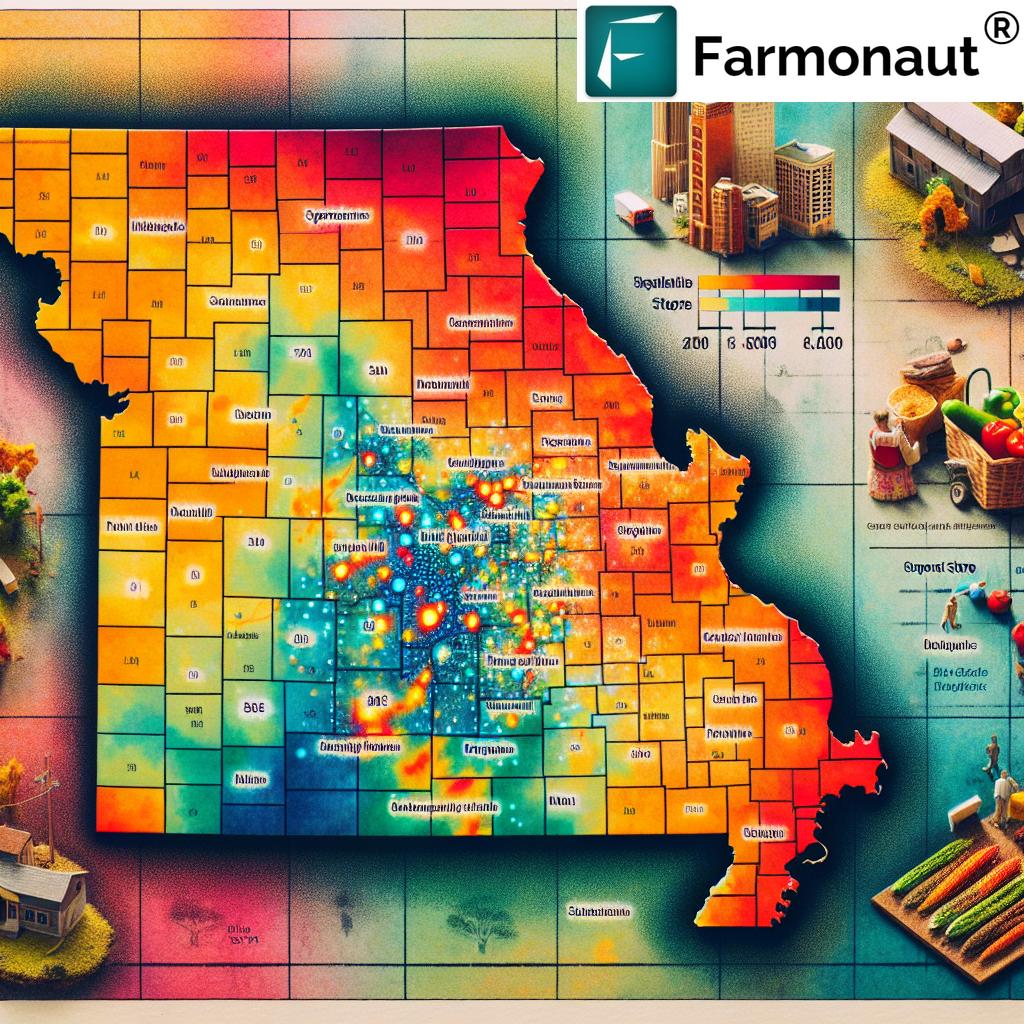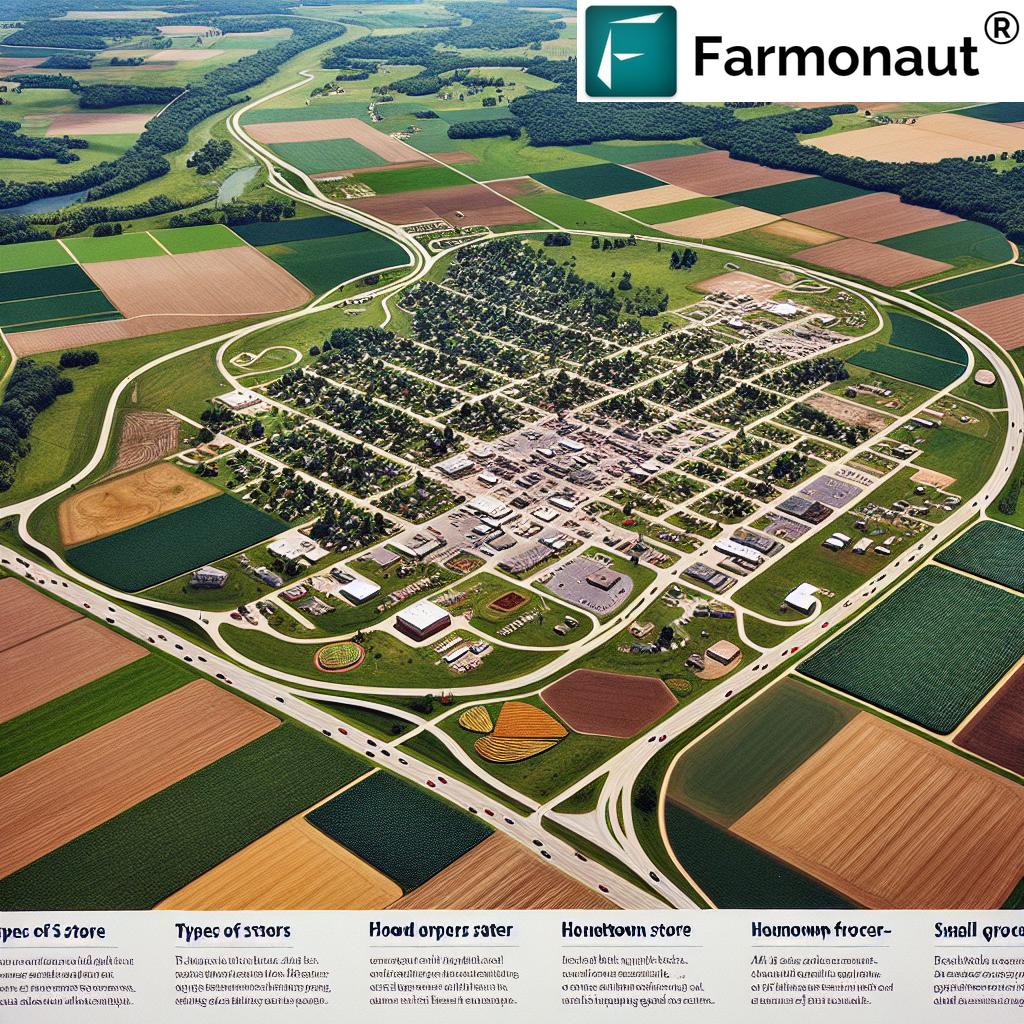Mapping Missouri’s Shifting Food Landscape: Farmonaut Analyzes Rural Grocery Store Trends and Food Access
“From 2009 to 2014, rural U.S. counties experienced significant shifts in food store distribution, impacting local economies and food access.”
Welcome to our comprehensive analysis of the dynamic food store distribution and grocery store density trends shaping rural food access across United States counties, with a special focus on Missouri. In this blog post, we’ll explore the evolving retail food landscape, examining changes in food store concentration from 2009 to 2014. Our team at Farmonaut has leveraged our expertise in agricultural technology and data analysis to provide valuable insights into this critical aspect of rural development and food security.
Understanding the Changing Landscape of Rural Food Access
The accessibility of food stores in rural areas is a crucial factor in determining the overall health and well-being of communities. As we delve into the data, we’ll uncover fascinating county-level food economics, revealing dramatic shifts in store numbers and their effects on healthy food availability. This analysis is essential for policymakers, researchers, and agricultural professionals seeking to understand and address the challenges faced by rural residents in accessing nutritious food options.

The Rise of Supercenters and Convenience Stores
One of the most significant trends we’ve observed in our analysis is the increasing prevalence of supercenters and convenience stores in rural areas. These large-format retailers have had a profound impact on local economies and food environments, often replacing traditional grocery stores and smaller specialized food markets.
- Supercenters: These one-stop shopping destinations offer a wide variety of products, including groceries, at competitive prices. Their emergence has changed the way rural residents shop for food and other household items.
- Convenience Stores: While not typically known for offering a wide selection of fresh foods, convenience stores have become increasingly important in rural areas where other food retail options may be limited.
The shift towards these store formats has both positive and negative implications for rural communities. On one hand, supercenters can offer lower prices and a broader selection of products. On the other hand, their presence may lead to the closure of smaller, locally-owned grocery stores, potentially reducing overall food store density in some areas.
The Role of Specialized Food Markets
Despite the growth of supercenters and convenience stores, specialized food markets continue to play a vital role in rural food environments. These stores, which may include farmers’ markets, bakeries, and specialty food shops, often provide unique products and support local agricultural economies.
Our analysis has shown that the number of specialized food markets varies significantly across counties, with some areas experiencing growth in this sector while others see declines. The presence of these stores can contribute to a more diverse and resilient local food system, offering consumers alternatives to larger chain retailers.
County-Level Food Economics: A Closer Look at Missouri
To better understand the nuances of rural food access, let’s examine some county-level data from Missouri. This state provides an excellent case study for the broader trends we’ve observed across the United States.
| County Name | Total Food Stores 2009 | Total Food Stores 2014 | Percent Change | Supercenters 2014 | Convenience Stores 2014 | Specialized Food Markets 2014 | Food Store Density 2014 (per 10,000 residents) |
|---|---|---|---|---|---|---|---|
| Schuyler County | 15 | 12 | -20% | 0 | 8 | 2 | 28.6 |
| Boone County | 120 | 135 | +12.5% | 3 | 85 | 15 | 7.8 |
| St. Louis County | 650 | 630 | -3.1% | 8 | 350 | 80 | 6.3 |
| Greene County | 180 | 195 | +8.3% | 4 | 110 | 25 | 6.8 |
| Ozark County | 18 | 15 | -16.7% | 0 | 12 | 1 | 15.2 |
This table illustrates the diverse trends across Missouri counties. We can observe that:
- Rural counties like Schuyler and Ozark experienced a decrease in total food stores, potentially impacting food access for residents.
- More populous counties like Boone and Greene saw an increase in food stores, likely driven by population growth and economic development.
- Convenience stores make up a significant portion of food retail outlets across all counties.
- Food store density varies widely, with rural counties often having a higher number of stores per capita despite lower total numbers.
“County-level analysis revealed dramatic changes in store numbers, with supercenters and convenience stores reshaping rural food landscapes.”
Factors Influencing Food Store Distribution
Several key factors contribute to the changing food store landscape in rural areas:
- Population Density: Areas with higher population density tend to attract more food retailers, including supercenters and specialized markets.
- Economic Conditions: Counties with stronger economies may see growth in food store numbers, while economically challenged areas may experience closures.
- Transportation Infrastructure: Accessibility via roads and public transportation can impact the viability of food stores in certain locations.
- Agricultural Production: Counties with strong local agricultural sectors may support more specialized food markets and direct-to-consumer sales.
- Consumer Preferences: Changing shopping habits and demand for certain types of foods can influence the mix of store formats in an area.
Implications for Healthy Food Availability
The shifts in food store distribution have significant implications for healthy food availability in rural areas. While supercenters often offer a wide variety of fresh produce and other nutritious options, their centralized locations may make access difficult for some rural residents. Convenience stores, which are more widely distributed, typically offer fewer healthy food choices.
To address these challenges, many communities are exploring innovative solutions:
- Mobile markets that bring fresh produce to underserved areas
- Community-supported agriculture programs linking consumers directly with local farmers
- Incentives for existing stores to stock and promote healthier food options
- Investments in public transportation to improve access to food retailers

The Role of Technology in Mapping Food Access
At Farmonaut, we understand the importance of leveraging technology to address agricultural and food access challenges. Our satellite-based farm management solutions provide valuable tools for analyzing crop health and management practices, which can indirectly support local food systems.
For example, our Jeevn AI Advisory System can help local farmers optimize their crop production, potentially increasing the availability of fresh, locally-grown produce in rural areas. Additionally, our blockchain-based traceability solutions can enhance transparency in food supply chains, building trust between producers and consumers.
To learn more about how Farmonaut’s technologies can support agricultural development and food access initiatives, visit our web app or explore our API services.
Challenges in Food Accessibility Mapping
Mapping and analyzing food accessibility in rural areas presents several challenges:
- Data Availability: Accurate, up-to-date information on food store locations and types can be difficult to obtain, especially for smaller, independent retailers.
- Geographic Scale: Rural counties often cover large areas, making it challenging to accurately represent food access for all residents within a single measure.
- Quality vs. Quantity: Simply counting the number of food stores doesn’t fully capture the quality or affordability of available food options.
- Temporal Changes: The food retail landscape can change rapidly, with stores opening and closing frequently, making it difficult to maintain current data.
To address these challenges, researchers and policymakers are increasingly turning to advanced mapping technologies and data integration techniques. At Farmonaut, we’re exploring ways to apply our expertise in satellite imagery and data analysis to contribute to more comprehensive food access mapping solutions.
Impact on Consumer Shopping Habits
The changing food store landscape has significantly influenced how rural residents shop for groceries. Some key trends we’ve observed include:
- Consolidation of Shopping Trips: With fewer local options, many consumers are making less frequent, larger shopping trips to supercenters or urban areas.
- Increased Reliance on Convenience Stores: For day-to-day needs, rural residents may depend more heavily on nearby convenience stores.
- Growth in Online Shopping: E-commerce and grocery delivery services are becoming more popular, even in rural areas, though availability can be limited.
- Support for Local Producers: There’s growing interest in purchasing directly from local farmers and food producers, supporting community-based food systems.
These changing habits have implications for local economies, community health, and social interactions. Understanding these shifts is crucial for developing effective strategies to improve food access and support rural development.
The Future of Rural Food Access
As we look to the future, several trends and innovations are likely to shape rural food access:
- Technology Integration: Advanced mapping tools, mobile apps, and e-commerce platforms will play an increasingly important role in connecting consumers with food sources.
- Community-Based Solutions: Local initiatives such as food cooperatives and community gardens may help fill gaps in the retail food landscape.
- Policy Interventions: Government programs aimed at supporting rural grocery stores and improving transportation infrastructure could help maintain and improve food access.
- Sustainable Agriculture: The growth of sustainable and regenerative farming practices may lead to more diverse local food options in rural areas.
At Farmonaut, we’re committed to supporting these positive trends through our innovative agricultural technology solutions. Our tools for crop monitoring, farm management, and supply chain traceability can contribute to more resilient and sustainable local food systems.
Explore how Farmonaut can support your agricultural initiatives:
Conclusion: A Call to Action for Improved Rural Food Access
Our analysis of rural grocery store trends and food access in Missouri and across the United States reveals a complex and evolving landscape. The shifts in food store distribution, driven by factors such as the rise of supercenters and changing consumer habits, have significant implications for the health and well-being of rural communities.
As we move forward, it’s crucial that policymakers, researchers, and community leaders work together to develop innovative solutions that ensure equitable access to healthy, affordable food for all rural residents. By leveraging technology, supporting local food systems, and implementing thoughtful policies, we can create a more resilient and sustainable rural food environment.
At Farmonaut, we’re committed to supporting these efforts through our advanced agricultural technology solutions. By providing tools that help farmers optimize their production and connect more directly with consumers, we aim to contribute to stronger, more sustainable local food systems.
Frequently Asked Questions
- Q: How has the number of grocery stores in rural areas changed over time?
A: Our analysis shows that many rural areas experienced a decrease in the total number of grocery stores between 2009 and 2014, often offset by an increase in supercenters and convenience stores. - Q: What impact do supercenters have on rural food access?
A: Supercenters can provide a wide variety of food options at competitive prices, but their centralized locations may make access difficult for some rural residents, especially those without reliable transportation. - Q: How do convenience stores affect healthy food availability in rural areas?
A: While convenience stores are often more widely distributed in rural areas, they typically offer fewer healthy food choices compared to full-service grocery stores or supermarkets. - Q: What role do specialized food markets play in rural food environments?
A: Specialized food markets, such as farmers’ markets and local produce stands, can provide fresh, locally-sourced options and support local agricultural economies, though their availability varies widely across rural areas. - Q: How can technology improve food access in rural areas?
A: Technology can help through improved mapping of food resources, connecting consumers with local producers, and optimizing agricultural production to increase local food availability.
For more information on how Farmonaut’s agricultural technology solutions can support rural development and food access initiatives, please visit our website or contact our team directly. Together, we can work towards a future where all communities have access to the healthy, affordable food they need to thrive.



